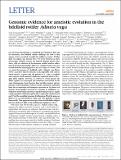Genomic evidence for ameiotic evolution in the bdelloid rotifer Adineta vaga
Author(s)
Kellis, Manolis; Jaillon, Olivier
DownloadKellis_Genomic evidence.pdf (665.4Kb)
PUBLISHER_CC
Publisher with Creative Commons License
Creative Commons Attribution
Terms of use
Metadata
Show full item recordAbstract
Loss of sexual reproduction is considered an evolutionary dead end for metazoans, but bdelloid rotifers challenge this view as they appear to have persisted asexually for millions of years1. Neither male sex organs nor meiosis have ever been observed in these microscopic animals: oocytes are formed through mitotic divisions, with no reduction of chromosome number and no indication of chromosome pairing2. However, current evidence does not exclude that they may engage in sex on rare, cryptic occasions. Here we report the genome of a bdelloid rotifer, Adineta vaga (Davis, 1873)3, and show that its structure is incompatible with conventional meiosis. At gene scale, the genome of A. vaga is tetraploid and comprises both anciently duplicated segments and less divergent allelic regions. However, in contrast to sexual species, the allelic regions are rearranged and sometimes even found on the same chromosome. Such structure does not allow meiotic pairing; instead, we find abundant evidence of gene conversion, which may limit the accumulation of deleterious mutations in the absence of meiosis. Gene families involved in resistance to oxidation, carbohydrate metabolism and defence against transposons are significantly expanded, which may explain why transposable elements cover only 3% of the assembled sequence. Furthermore, 8% of the genes are likely to be of non-metazoan origin and were probably acquired horizontally. This apparent convergence between bdelloids and prokaryotes sheds new light on the evolutionary significance of sex.
Date issued
2013-07Department
Massachusetts Institute of Technology. Computer Science and Artificial Intelligence LaboratoryJournal
Nature
Publisher
Nature Publishing Group
Citation
Flot, Jean-François, Boris Hespeels, Xiang Li, Benjamin Noel, Irina Arkhipova, Etienne G. J. Danchin, Andreas Hejnol, et al. “Genomic Evidence for Ameiotic Evolution in the Bdelloid Rotifer Adineta Vaga.” Nature 500, no. 7463 (July 21, 2013): 453–457.
Version: Final published version
ISSN
0028-0836
1476-4687